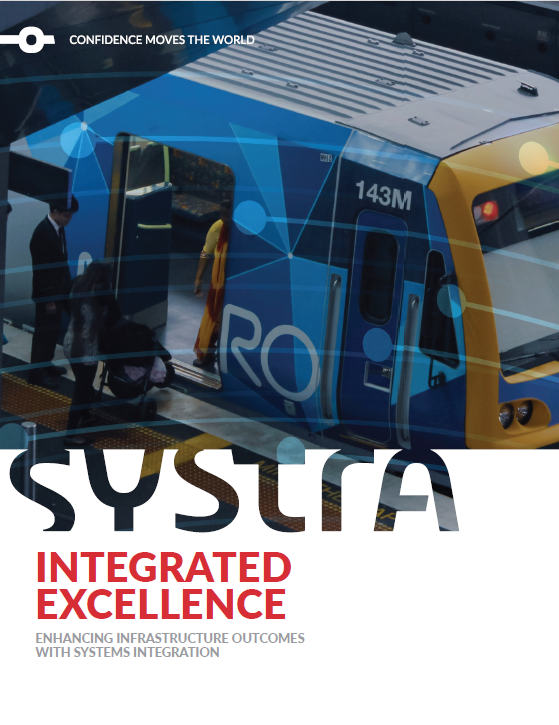Regardless of the industry, the success of modern infrastructure projects relies on the seamless collaboration of diverse technologies, processes, and stakeholders. At the heart of this intricate and highly complex relationship lies Systems Integration – a disciplined and holistic approach that brings these critical components together.
This article delves into the fundamental aspects of Systems Integration, exploring its role in project success, and why the approach taken matters. We unravel the challenges presented by increasingly intricate systems, shed light on the impact of systems integration risk, and showcase the distinctive SYSTRA difference – a whole of life and strategic approach that sets projects up for success.
What is systems integration?
Systems Integration is a highly specialised service offering that enables infrastructure projects to perform at their peak. It focusses on bringing together the various components of a project such as technology, processes, and stakeholders to create a more unified, seamless and interoperable whole.
Systems Integration works by viewing each project from a whole-of-network perspective to facilitate greater transparency, collaboration and decision making throughout the project lifecycle. This strategic approach enables outcomes related to efficiency, safety, and cost while also managing and reducing the risk of delays, cost escalations and projects not meeting their desired outcome. Systems integration is a versatile offering that is integral to the success of projects within the defence and aerospace, telecommunications, transportation, and energy sectors.

Systems Integration is a critical area of focus
Infrastructure and the way we develop it is changing. New technologies, resources, modern processes, competition and evolving industries have created a highly complex web of components necessitating a sophisticated and strategic approach to complete projects within the constraints of community expectations, time, scope, and budget.
As the complexity of the infrastructure ecosystem increases, the importance of harmonising the various components has never been more critical. And yet, despite the complexity and the critical importance of Systems Integration, it is not being employed in a manner that fully capitalizes on its intended advantages.
Rob Scarbro, Director – Systems Integration, SYSTRA ANZ has seen an evolution of organisations developing approaches to understanding and managing Systems Integration on major projects . One of the main constraints limiting its ability to influence projects is that it has not been properly defined as a service offering.
To me, Systems Integration is as simple as identifying the areas that require integration and then working collaboratively with stakeholders to find the right solution within the constraints of the project.
However, systems teams are traditionally called upon late in the project lifecycle to manage risk and deliver outcomes. The problem with this approach is that the systems team is required to unify the many components together at a time when decisions have been made and budget and time constraints are high. It often means the role of a systems integrator is valued significantly lower than other civil elements while also carrying a higher level of risk.
Rob Scarbro, Director – Systems Integration, SYSTRA ANZ
One of the most common risks of not properly implementing Systems Integration is related to interoperability, a problem where systems, sub-systems and technologies fail to collaborate with one another creating further inefficiencies, costs, and safety risks.
One example of this is covered in Interoperability – The Fast Track to a Seamless, Safer Railway System. It details how the lack of systems integration in the Australian railway network over time has led to:
- 29 different networks operating to different standards
- 3 different railway gauges requiring specific manufacturing
- 11 separate signalling and train control systems
- 17 safe-working systems
- 50 different operators across both freight and passenger rail
The outcome is a highly fragmented network that is going to cost time, money, and resources to fix. It’s even been identified as one of National Cabinet’s key priorities to address.
The rail network is not alone. Most industries are prone to significant delays and cost-blowouts. As recently as November 2023, it was flagged that major cuts to Australian infrastructure projects were looming amid a $33 billion cost-blowout.
Systems integration reduces and manages risk to ensure the elements of a project are interoperable and that there are clear and defined roles for stakeholders from the tender phase onwards.
Early integration ensures performance, safety and cost-savings
A systems-led approach, implemented by an experienced and trusted integrator in the early stages of a project, will help set a project up for success. It ensures stakeholder responsibilities are identified and the performance, safety and financial needs of a project are met. Crucially, it also ensures infrastructure owners are getting more value out of every dollar spent resulting in more projects being completed.
“We need to mobilise the systems input, in a timely manner that recognises the delivery timescales and place more importance on the higher areas of systems integration risk early.
“The early integration of a systems approach into the project lifecycle led by a designated team may cost more in the short term, but as people, process and technologies start to collaborate, then the return is on the money you don’t waste. It avoids problems related to interoperability and ensures projects are delivered on time, within scope and in line with community and stakeholder expectations.”
Rob Scarbro, Director – Systems Integration, SYSTRA ANZ
With systems risk causing strain on the infrastructure pipeline, Rob believes now is the time for stakeholders to address their system’s needs.
He adds, “For the communities to reap the absolute benefits from these projects, it’s important that Systems Integration is not an afterthought but an ongoing part of the entire project.”
It’s in our DNA
Systems Integration is in the SYSTRA DNA. Across the world we have provided innovative solutions to shape the future of our communities. We offer our clients a whole-of-life transdisciplinary service across all infrastructure sectors including defence where we actively work with owners, contractors and the entire network of stakeholders to be the integrator of choice.
We provide a versatile offering that is not bound by traditional integration strategies, and instead backed by global expertise, innovation, and proven experience. We approach each project from a whole-of-network perspective to ensure we are providing our clients with tailored solutions that solve complex problems and allow infrastructure to operate at their peak.
Want more content like this?

Integrated Excellence
Our publication delves into the vital role of Systems Integration in infrastructure projects. As projects grow in complexity, the effective integration of technologies, systems, sub-systems and existing infrastructure becomes crucial for success.
By downloading this publication you will get a better understanding of how Systems Integration identifies and connects these components into a single, fully functioning whole, mitigating risks and improving transparency and decision-making.
Want more information?

- services
Systems Integration
Read more sur Systems Integration
- services
Rail Telecommunications
Read more sur Rail TelecommunicationsNeed more information?
For more information, please get in contact with us. Alternatively, if you wish to keep in touch please hit subscribe.


 Brazil
Brazil  Canada
Canada  Chile
Chile  China
China  Columbia
Columbia  Denmark
Denmark  Egypt
Egypt  France
France  India
India  Indonesia
Indonesia  Ireland
Ireland  Italy
Italy  Malaysia
Malaysia  Norway
Norway  New Zealand
New Zealand  Panama
Panama  Peru
Peru  Poland
Poland  Portugal
Portugal  Saudi Arabia
Saudi Arabia  Singapore
Singapore  South Korea
South Korea  Spain
Spain  Sweden
Sweden  Taiwan
Taiwan  Thailand
Thailand  Türkiye
Türkiye  United Kingdom
United Kingdom  United States
United States  Vietnam
Vietnam